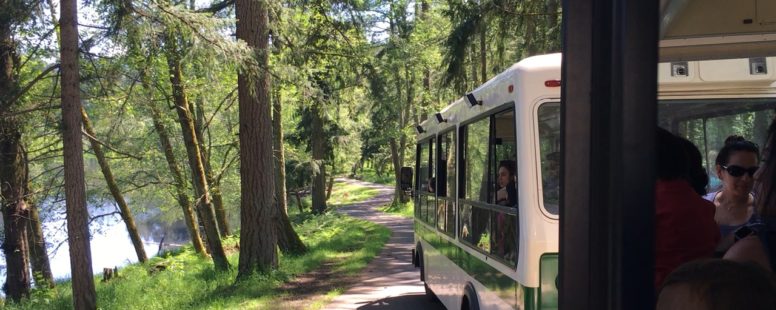Get back to nature at Northwest Trek Wildlife Park
In the 1930’s, Dr. David and Connie Hellyer purchased over 400 acres of land in east Pierce County. They lived there, they made their home there, and they took care of the land for over 40 years. And in 1975, they opened Northwest Trek Wildlife Park near Eatonville, Washington.

This story begins in the majestically-forested foothills near Mount Rainier. Located just six miles north of Eatonville, the lush landscape surrounding Horseshoe Lake was once anything but. Harvested for decades by the Saint Paul and Tacoma Lumber Company, the land was stripped bare and wildlife was scarce. Shortly after planting a new crop of trees in 1921, a devastating wildfire swept through the area in 1925 destroying everything.
Rather than double down on their losses, Saint Paul Tacoma decided to cut their parcel loose…100 charred acres for just four dollars and fifty cents an acre. That’s when David and Connie Hellyer seized the opportunity to purchase the land in 1937, writing two checks totaling just $450.
Right now, 100 acres of land near Eatonville costs over $10,000 per acre. Adjusting for inflation, the Hellyers got the same size property for just $78 bucks an acre in today’s dollars.
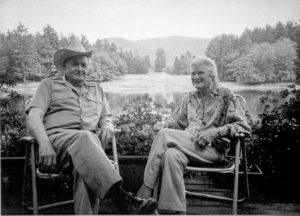
David and Connie Hellyer.
They built a modest cabin and lived their lives, watching the land resurrect itself around them through the years. By the time the good doctor was ready to take his life in a new direction, the wilderness had fully returned to Horseshoe Lake.
In 1971, David and Connie Hellyer donated their land to the Tacoma Metropolitan Parks District, with the explicit intent to create a conservation habitat that the public could enjoy. After four years of diligent fundraising and planning, Northwest Trek officially opened its doors on July 17, 1975.
Visitors to the attraction today will find three main areas of the park: the ever-popular 45-minute tram ride through the open lands, the walking paths through other animal exhibits, and hiking trails through the undeveloped areas.
On entering the park, families are met with a wall of sketches depicting the animals they’ll soon see, along with an homage to the property’s timber-felling past. As I went to find the large map of the park situated conveniently just inside the gate, I ran into one of the park’s employees.
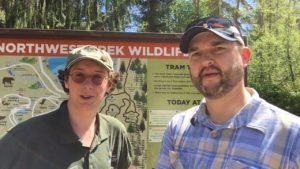
Naturalists are not to be confused with naturists.
Eli Loftus has been a naturalist at Northwest Trek Wildlife Park since 2012. He teaches adults and children about ecology, zoology, and tries to impart the conservation message of Northwest Trek…that everyone has a home and that everyone can make a difference.
Eli told me about the history of the park and its founders, the variety of amenities the park has to offer – like a restaurant, gift shop and picnic areas – and brought me up to speed on the different expansions the park has undergone since its opening, including the most recent addition – Kids’ Trek.
Inside, you’re going to find a lot of kid-based activities. There’s statues, sculptures, poles for climbing, and a very nice stream for the kids to play with, especially on hot days. Eli says it’s just a really nice addition to the park.
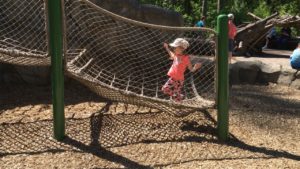
Made for spiders of all ages.
Kids’ Trek is an adventure playground inspired by nature, where kids can climb like spiders on a rope net web, slide down a tree trunk or walk the rope bridge to hide inside the giant stump.
Plus, just inside Kids’ Trek, you’re going to be greeted with several statues of wild animals they have at the park – like a pair of cougars – and, as a Washington State University graduate, I can’t let an opportunity pass to say…Go Cougs!
Kids’ Trek is perfect for birthday parties thanks to the outdoor picnic shelter nestled right between it and the park’s restaurant. There’s all sort of nature themed play, and adults can sit and watch comfortably from the shaded shelter as their little ones discover what conservation is all about.
Once the kids burn off that cheeseburger or birthday cake, it’s time to take a ride! Northwest Trek’s Discovery Tram Tour is a unique way to see wildlife, taking you through stunning meadows and forests to come eye-to-eye with free-roaming herds of Roosevelt elk, bighorn sheep, mountain goats, and more.
A friendly naturalist narrates each 40-minute tour, and every season offers something new. Tours leave about every hour and are free with admission or membership. Go as many times as you’d like…it is easily the highlight of the park, as evidenced by the size of the crowd.
My tram ride began with some safety instructions before moving on to find a seat in one of the tram cars. Some advice, if you have loud or active kids, you should pick one of the rear two cars. In the lead car, you’ll have the opportunity to ask the driver questions about what you’re seeing. And don’t worry if you don’t get to sit by a window. Every seat is a good one on this ride.
As the tram winds its way leisurely through the park, you really will get up close and personal with various species native to the western United States, starting with the caribou who like to hang out around the tram station. Also known as reindeer, these hefty creatures can weigh up to 400 pounds. Caribou are members of the deer family – known as ungulates – and both cows and bulls can grow antlers. Their light grey winter coat gets shed before summer to reveal dark gray or black underneath.
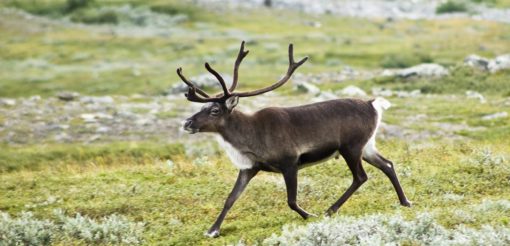
Black is the new black.
Somewhere along the way, you’re sure to encounter a herd of mountain goats, though they’re often feeling shy when babies are present or on the way. Weighing up to 300 pounds, these ungulates will find cool shady spots and create dust wallows in the summer heat. But don’t be fooled by all the lounging around. Nannies can be very aggressive when necessary, wielding their horns effectively to guard their kids and dominate males.
When cruising between animal herds, your guide will often slow down and point out the less exotic but equally important species found in Washington, such as ducks, swans, geese, turtles, and deer. Columbian black-tailed deer to be specific.
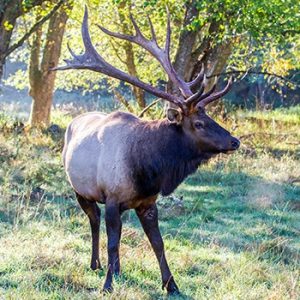
It’s a wapiti, people. Look it up.
Related to the deer, Roosevelt elk – or, more accurately, wapiti – also make their home at Northwest Trek. Adult males can weigh up to 11-hundred pounds…impressive, considering these ungulates live on a diet of leaves and grasses. Though I’ve not heard one in the wild, I’m told the bugling call of bulls in rut is a haunting sound not easily forgotten.
The free roaming area is also home to moose (who were playing hooky the day I visited), as well as bighorn sheep. Rounding a corner, we were surprised by a dozen or more bighorns marching along a roadway like a military column. So surprised, in fact, that I didn’t have time to get my camera ready. The 300-pound rams will stay in bachelor herds except during breeding season, when they compete in fierce head-butting jousts to determine dominance. The crack of bighorns engaged in battle sounds like a rifle shot echoing across the valley.
Perhaps the most eagerly awaited sight on the tram tour also happens to be the largest land mammal in North America (and one of my personal favorites). American bison come in two flavors: the Wood Bison and the Plains Bison, which is the species at Northwest Trek. These noble, majestic creatures are so unique that their scientific name is bison bison bison…almost as if scientists knew that people were going to mistakenly call them “buffalo.”
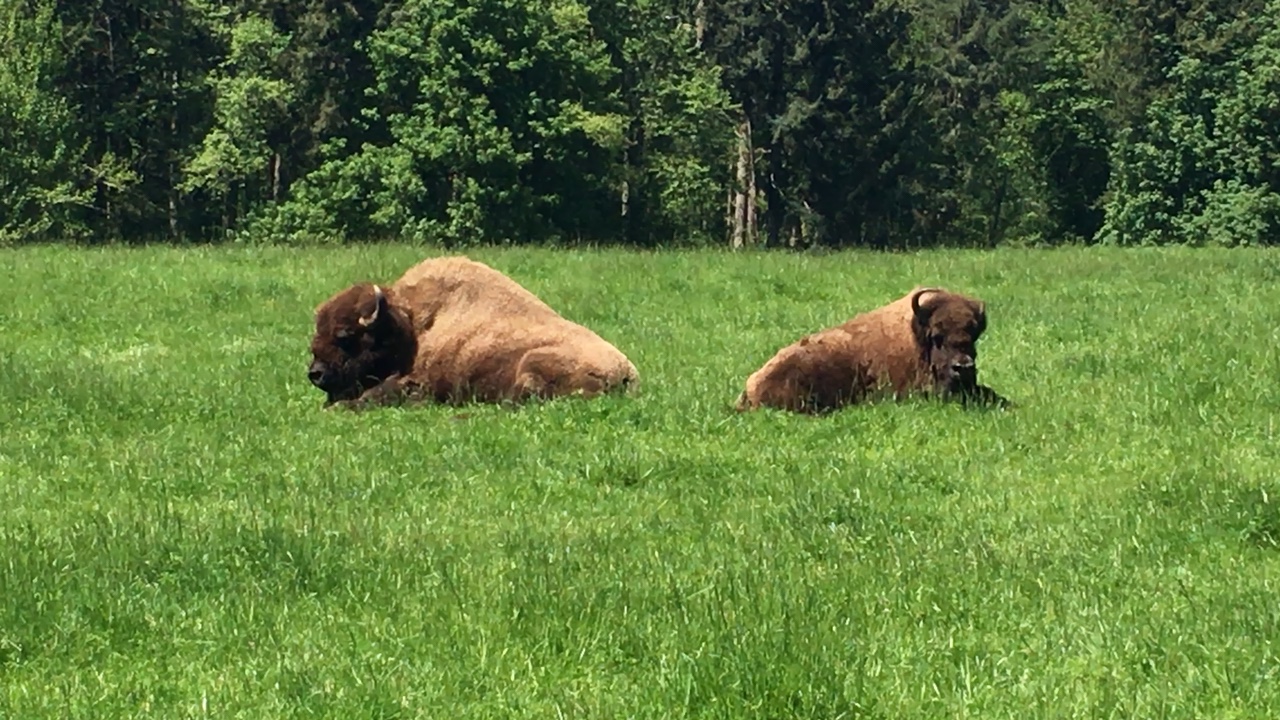
Not buffalo.
These guys get up to 15-hundred pounds and can appear slow because of their lethargic movements, rolling in dust and mud to control parasites. But a full-grown bison can easily outrun humans, clocking a top speed of 40 miles per hour. If the bison are active on the day you’re visiting Northwest Trek, there’s no doubt you’ll leave feeling like you got your money’s worth.
But why even think about leaving? There’s so much more to see at Northwest Trek Wildlife Park!
In part two, we’ll learn how high the mountain lion can leap, meet a pair of fearless foxes, and watch as a trio of wily wolves hunt down their next meal. Check out the video below for more of the Northwest Trek experience!

